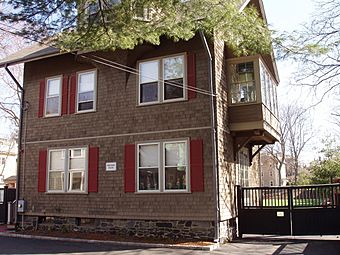Percy W. Bridgman House facts for kids
|
Percy W. Bridgman House
|
|

Percy W. Bridgman House.
|
|
| Location | Cambridge, Massachusetts |
|---|---|
| Built | 1928 |
| NRHP reference No. | 75000298 |
Quick facts for kids Significant dates |
|
| Added to NRHP | May 15, 1975 |
| Designated NHL | May 15, 1975 |
The Percy W. Bridgman House is a special old house located in Cambridge, Massachusetts, United States. It is known as a National Historic Landmark. This means it is a very important place in American history. The house is famous because a brilliant scientist named Percy Williams Bridgman lived there. He was a physicist and won a Nobel Prize. Today, the house is part of the Buckingham Browne & Nichols (BBN) Lower School campus.
Contents
Discovering the Percy W. Bridgman House
This house was built around 1920. It has two and a half stories. The house was made in a style called Neo-Rationalist. When it was named a National Historic Landmark in 1975, it looked much the same as when Dr. Bridgman lived there.
What Makes This House Special?
The Percy W. Bridgman House is important because of its connection to Dr. Percy Bridgman. He was a professor at Harvard University. After he passed away in 1961, the BBN School bought the house.
Today, the school uses the house for its offices. It has also been used for other things. These include being a home for teachers and a place for them to relax.
Who Was Percy Bridgman?
Percy Bridgman was born in Cambridge in 1882. He grew up in Newton. He went to Harvard University for his education. In 1908, he earned his Ph.D. in physics.
After finishing his studies, Bridgman joined the physics team at Harvard. He stayed there for his entire career. He was a dedicated and brilliant scientist.
Bridgman's Amazing Discoveries
Percy Bridgman's main research was in high pressure physics. This means he studied how materials behave under very strong pressure. He created special equipment to do this research. His inventions helped scientists learn new things about the world.
In 1946, he won the Nobel Prize in Physics. He was the fifth American to receive this great honor. He won it for his important work in high pressure physics.
Life at Harvard and Home
Bridgman also wrote many books and papers. He explored how we understand physics and science. His ideas helped create a field called operations research in the 1940s. This field uses science to help make better decisions.
Dr. Bridgman moved into this house in 1928. He lived there for the rest of his life. He passed away in 1961. The house remains a reminder of his incredible contributions to science.



